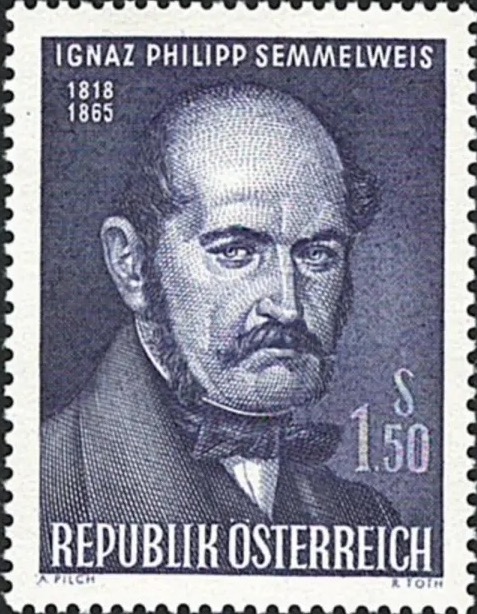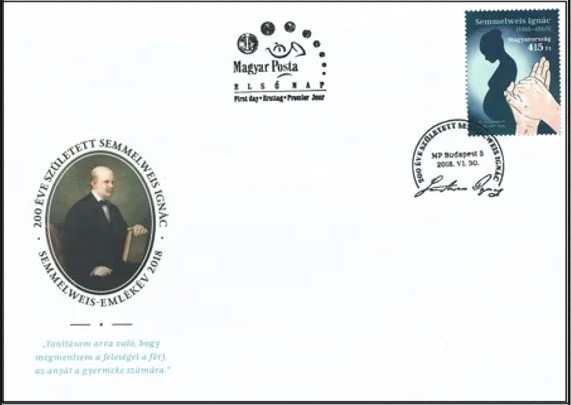Dr. Ignaz Semmelweis was a Hungarian physician who made a groundbreaking discovery about the importance of hand hygiene in the 19th century. Here is his story, a testament to the power of observation, perseverance and the pursuit of evidence-based medicine.
In the 1840s, puerperal fever*, a deadly infection, was rampant in maternity wards across Europe. The mortality rate was alarmingly high, with some hospitals reporting rates as high as 20-30%.
Young Semmelweis was working as a resident doctor in the maternity ward of Vienna General Hospital, where he was deeply troubled by the high mortality rate. He noticed a significant difference in mortality rates between the hospital’s two maternity wards:
- In Ward 1, staffed by doctors and medical students, the mortality rate was around 10-15%.
- In Ward 2, staffed by midwives, the mortality rate was significantly lower, around 2-3%.
Semmelweis hypothesised that the difference in mortality rates was due to the doctors and medical students coming directly from the autopsy room, where they were handling cadavers, to the maternity ward, without washing their hands. He believed that “cadaverous particles” were being transferred to the patients, causing the infections.
Semmelweis introduced a simple yet revolutionary practice: hand washing with soap and water before entering the maternity ward. He also emphasised the importance of cleaning medical instruments.
After implementing hand hygiene practices, the mortality rate in Ward 1 plummeted, becoming comparable to Ward 2. Semmelweis’s intervention demonstrated a clear causal link between hand hygiene and reduced mortality.
Despite his success, Semmelweis faced significant resistance, scepticism and antagonism from his colleagues and superiors. His ideas were met with ridicule, and he struggled to get his findings published. Unable to convince the medical fraternity of his seminal discovery, the good doctor developed a mental condition that confined him to a mental asylum, where he was probably neaten to death.
His findings earned widespread acceptance only years after his death, when Louis Pasteur confirmed the germ theory, giving Semmelweis’ observations a theoretical explanation, and Joseph Lister, acting on Pasteur’s research, practised and operated using hygienic methods with great success.
Semmelweis’s discovery of the importance of hand hygiene in preventing infections did eventually get recognition as a major breakthrough in medicine. Today, hand hygiene is a cornerstone of infection control and patient safety.
Dr. Ignaz Semmelweis’s story is a testament to the impact one person can have on medicine and public health. His pioneering work on hand hygiene has saved countless lives and continues to inspire healthcare professionals today. The Semmelweis story is often used in university courses with epistemology content, e.g. philosophy of science courses—demonstrating the virtues of empiricism or positivism and providing a historical account of which types of knowledge count as scientific (and thus accepted) knowledge, and which do not.
* Puerperal fever, also known as postpartum fever or childbed fever, occurs within the first few days to a week after childbirth. It is primarily caused by a bacterial infection of the reproductive tract. While less common today due to advancements in hygiene and medical care, it was a significant cause of maternal mortality in the past.

Ignaz Philipp Semmelweis (1818-1865), a Hungarian physician and scientist of German descent, gained posthumous recognition as an early pioneer of antiseptic procedures and was described as the “saviour of mothers.” However, his simple ideas on hand hygiene did not go well with the medical community of those times, who refused to accept that they were the ones giving childbed fever to women during childbirth. His findings on antiseptic procedures were met with ridicule, and he struggled to establish them and get them published. Unable to convince the medical fraternity of his seminal discovery, the good doctor eventually developed a mental condition that confined him to a mental asylum. Dr. Semmelweis was probably beaten in the asylum and eventually died of sepsis, the same disease that he fought hard to prevent during childbirth. Image: Postage stamp issued by Austria in 1965 to honour Dr. Semmelweis on his 100th death anniversary.

A first day cover and a postage stamp were issued by Hungary on 30th June 2018 to commemorate the 200th birth anniversary of Dr. Semmelweis. The slogan on the cover says “….My teaching is to save a wife for a husband, and a mother for a child…”
Many European countries honoured Dr. Semmelweis with postage stamps over the years; please visit https://healthinstamps.com/ for complete philatelic details.
